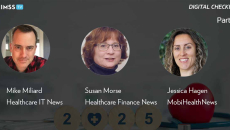Telehealth
For complete emergency telehealth services with multiple specialties for 365 days, Chase County Community Hospital pays the equivalent of having one backup physician by phone for approximately 45 to 60 days.
National Taiwan University Hospital has incorporated speech-to-text AI in its telehealth platform.
The rule would establish a framework for a telehealth controlled substance registry and authorize three types of special registration. Some industry groups have voiced concerns for providers in their initial reactions to the proposed rule.
The St. Louis pediatric hospital has fully integrated its in-house behavioral health team with vendor tele-psychiatrists – including in its Epic EHR. The percentage of new patients scheduled within 14 days has jumped from 14% to more than 60%.
Healthcare providers and IT vendors in the region have weighed in with their predictions for healthcare technology in the new year.
A virtual care CEO says telemedicine means more physicians in the mix, enabling them to delegate less-complex tasks. Health systems should then be able to reduce wait times with that newly expanded capacity.
A change in administration isn’t the only thing that promises an interesting year. Editors from Healthcare IT News, Healthcare Finance News and MobiHealthNews discuss what to look for in telehealth and RPM, and emerging policies in AI and cybersecurity.
Remote Patient Monitoring
As one telemedicine CEO looks to the year ahead, he predicts RPM will improve outcomes for congestive heart failure patients and help manage those on the wildly popular GLP-1 diabetes and weight loss medications.
Computer vision and sensor integration, evolution in virtual specialty care and other innovations are transcending the hype cycle and showing results, says one telehealth leader.
Stripped out of the final bill is a provision to prevent the 2.8% Medicare pay cut to physicians.








